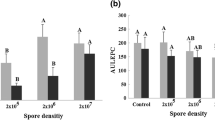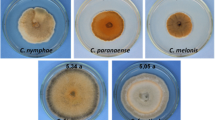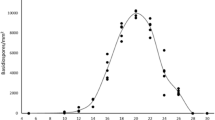Abstract
Corynespora cassiicola (Berk and Curt) Wei, incitant of leaf spot of brinjal, survives at the room temperatures (28–30° C) for a period of 4 months in infected dry leaves, in infected dead stems for 10 months, and for 11 months in chicken mesh wire house where natural diurnal fluctuating temperatures prevail. Masses of bulbous conidiophore bases appearing like sclerotial bodies, conidiophores and chlamydospores may also help in the survival of the fungus. The weed hostsCroton sparsiflorus Mor.Leucas aspera Spr,Ocimum sanctum L.,Solanum nigrum L., andDigera arvensis Forsk, may act as additional reserviors of inoculum for the disease spread. The fungus survives on chilli crop during summer and this may also serve as primary source of inoculum in July for brinjal crop.
Similar content being viewed by others
References
Asharam and Lele, V. C... “A new leaf spot disease of brinjal caused byCorynespora cassiicola (Berk and Curt) Wei,”Indian Phytopath., 1968,21, 347–48.
Blazaquez, C. H... “Corynespora cassiicola on bananas,”Phytopathology, 1969,59, 1347 (Abstr.).
Boosalis, M. G. and Hamilton, R. I. “Root and stem rot of soybean caused byCorynespora cassiicola (Berk and Curt) Wei,”Plant Dis. Reptr., 1957,41, 696–98.
———, Sumner, D. R. and Rao, A. S. “Overwintering of conidia ofHelminthosporium turcicum on corn residue in soil in Nebraska,”Phytopathology. 1967,57, 990–96.
Demidova (Mme) Li.. “Some problems of biology of fungusC. cassiicola, the causal agent of black mold of cucumber.”Mem. Inst. agron, Leninger., 1962,87, 91–95. (In Russian;R.A.M., 1962,43, 1271.)
Ellis, M. B... “Some species ofCorynespora,”Mycol. Pap. C.M.I., 1957,40, 65
Jones, J. P... “A leaf spot of cotton caused byCorynespora cassiicola (Berk and Curt) Wei,”Phytopathology, 1961,51, 305–08.
Karan, D... “Some diseases of castor beans (Ricinus communis L.,) from Hyderabad,”Mycopath. et. Mycol. appl., 1966,30, 187–89.
Merunouck, R. A. and Pepper, E. H. “Chlamydospore formation in conidia ofHelminthosporium sativum,”Phytopathology, 1968,58, 866–67.
Mohanty, U. N. and Mohanty, N. N. “Target spot of tomato,”Sci. & Cult., 1955,21, 330–32.
Ramakrishnan, T. S... “Notes on some fungi of South India, VIII,”Proc. Ind. Acad, Sci., 1960,51 B, 164–68.
Roy, A. K... “Additions to the fungus flora of Assam—I,”Indian Phytopath. 1965,18, 327–334.
Stone, W. J. and Jones, J. P... “Corynespora leaf blight of sesame,”Phytopathology., 1960,50, 263–66.
Seaman, W. L. and Shoemaker, R. A... “Pathogenicity ofCorynespore cassiicola (Berk and Curt) Wei on soybean,”Can. J. Bot., 1965,43, 1461–69.
Tirumalachar, M. J. and Lacy, R. C... “Notes on some Indian fungi—I,”Sydowia, 1951,5, 124–28.
Wei, C. T... “Notes onCorynespora cassiicola,”Mycol. Pap., C.M.I., 1950,34, 9.
Author information
Authors and Affiliations
Additional information
Communicated by Prof. T. S. Sadasivan,f.a.sc.
Rights and permissions
About this article
Cite this article
Sarma, Y.R., Nayudu, M.V. Corynespora leaf spot of brinjal. Proc. Indian Acad. Sci. 74, 92–97 (1971). https://doi.org/10.1007/BF03050385
Received:
Issue Date:
DOI: https://doi.org/10.1007/BF03050385




